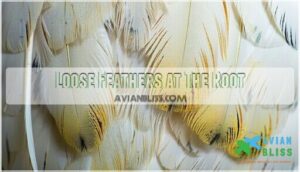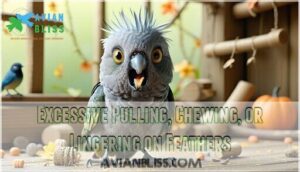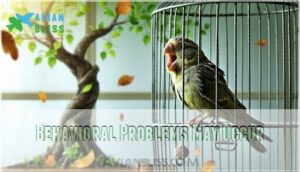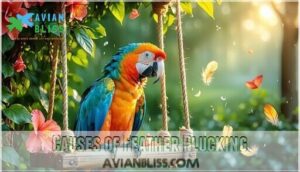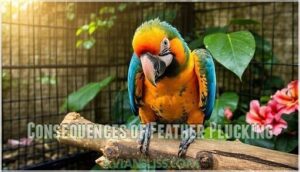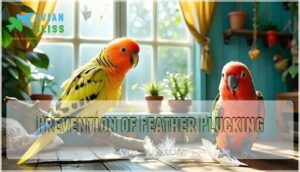This site is supported by our readers. We may earn a commission, at no cost to you, if you purchase through links.
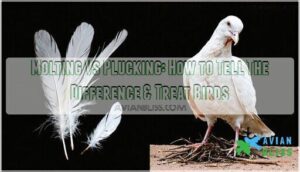
Molting is natural—feathers fall out easily with intact roots, minimal effort, and no distress. Your bird won’t obsess over the process.
Plucking, however, involves excessive pulling, chewing, or manipulation. You’ll see damaged feathers with broken quills, chewed shafts, and bald patches.
Birds may vocalize during plucking and exhibit behavioral changes. Molted feathers appear clean and complete, while plucked ones show obvious trauma.
If you’re finding pristine feathers, it’s likely molting. Damaged feathers signal plucking—a behavioral or medical concern requiring intervention. Understanding these patterns reveals whether patience or professional help is needed.
Table Of Contents
- Key Takeaways
- Understanding Molting
- Identifying Molting
- Understanding Feather Plucking
- Identifying Feather Plucking
- Causes of Feather Plucking
- Consequences of Feather Plucking
- Treatment for Feather Plucking
- Prevention of Feather Plucking
- Frequently Asked Questions (FAQs)
- How do you tell if your bird is molting?
- Can birds recover from plucking?
- What is the difference between molting and plucking?
- Are birds molting or plucking?
- What is the difference between molting and plucking a parrot?
- What is the difference between molting and plucking a conure?
- What does molting a bird mean?
- Why do chickens molt?
- How long does a typical molting cycle last?
- Can environmental factors influence the timing of molting?
- Conclusion
Key Takeaways
- Check the feathers themselves – You’ll find that molted feathers are complete with intact roots and fall out easily, while plucked feathers show broken quills, chewed shafts, and obvious damage from forceful removal.
- Watch your bird’s behavior – During molting, your bird won’t obsess over feathers or show distress, but plucking involves excessive pulling, chewing, and you might even hear squeaking sounds during the process.
- Look at the pattern of feather loss – Molting creates symmetrical feather loss without bald spots, while plucking results in irregular bare patches and exposed skin areas.
- Recognize when intervention is needed – If you see damaged feathers, bald patches, or behavioral distress, it’s plucking that requires addressing underlying causes, such as stress, boredom, or medical issues, rather than waiting it out.
Understanding Molting
Understanding molting begins with recognizing this natural feather renewal process. Why do birds shed their feathers? It’s nature’s way of maintaining healthy feather health through systematic replacement.
The molting process occurs seasonally, typically once or twice yearly during seasonal molting periods. Hormonal influence triggers this molting cycle, causing old feathers to loosen and fall out symmetrically.
You’ll notice feather symmetry as birds lose feathers in predictable patterns, never creating bald spots. Molting duration varies by species and age, lasting 8-16 weeks through distinct molting stages.
During bird molting, expect behavioral changes. Your feathered friend becomes quieter and less active while conserving energy for regrowth. Pin feathers emerge as protective sheaths, appearing like small spikes across their body.
This molting season isn’t painful—it’s essential maintenance that guarantees strong, vibrant plumage for perfect flight, insulation, and waterproofing throughout the year.
Identifying Molting
When you’re observing your bird during molting season, you’ll notice feathers that come loose naturally at their root without any force or struggle.
These molted feathers often appear slightly worn or tattered, but they fall out easily as part of your bird’s healthy renewal process.
Loose Feathers at The Root
When you’re checking for molting, look for loose feathers at the root that indicate healthy Root Feather Health. These feathers show Easy Feather Removal without resistance, displaying Regrowth Smoothness and Consistent Feather Color.
Unlike feather plucking, the molting process produces naturally loose feathers with intact roots. Even Tattered Feathers Normal during bird molting don’t signal problems—they’re part of natural feather loss patterns.
Minimal Effort Required to Remove Feathers
During the molting process, feathers release with gentle pressure—no yanking needed.
This natural feather loss signals healthy regrowth patterns, unlike feather plucking where birds forcefully remove feathers.
You’ll observe smooth, consistent feather care as old plumage makes way for vibrant new growth.
- Feathers slide out effortlessly when touched or brushed
- No resistance or tugging sensation during removal
- Clean follicles show no trauma or bleeding
- Bird remains calm without signs of discomfort or distress
Feathers May Be Mildly Tattered
Feather texture during the molting process can appear somewhat rough or disheveled, which is completely normal.
These tatter signs indicate healthy feather growth as old plumage naturally loosens before replacement.
Here’s what to watch for:
- Slightly frayed edges on wing and body feathers
- Uneven feather alignment creating a ruffled appearance
- Mixed textures where new pin feathers emerge alongside older ones
This temporary raggedness shows your bird’s molting cycle is progressing normally, with regrowth patterns following natural feather loss, and is a sign of normal molting cycle, indicating natural feather loss.
No Pain or Discomfort
One telltale sign of healthy molting is your bird’s relaxed behavior.
The molting process happens pain-free, unlike feather plucking which causes visible distress.
You’ll notice your feathered friend maintains normal bird comfort levels throughout natural shedding.
While the molting cycle progresses, feather health remains stable without stress signals or discomfort indicators that accompany problematic feather loss. The presence of relaxed behavior is a key indicator of a healthy molting process.
No Excessive Preening
During natural molting, your bird won’t obsessively fuss with its feathers like it’s picking at a scab.
This healthy molting process maintains normal preening habits without stress-related behaviors.
Signs of healthy feather care during natural shedding:
- Gentle grooming sessions – Your bird preens calmly, not frantically picking at molting feathers
- Balanced attention – No fixation on specific body areas or excessive scratching behaviors
- Relaxed demeanor – Bird maintains normal activity levels without feather-focused anxiety
Understanding the bird molting process is essential for identifying healthy molting patterns in your pet bird.
Understanding Feather Plucking
While molting represents your bird’s healthy feather renewal, plucking behavior signals trouble brewing beneath the surface.
This destructive habit stems from various triggers that demand immediate attention to protect your feathered friend’s wellbeing.
| Root Causes | Warning Signs |
|---|---|
| Feather Stress from environment | Bare patches appearing |
| Bird Psychology disruption | Compulsive preening habits |
| Avian Health complications | Damaged feather shafts |
Plucking behavior differs dramatically from natural feather molting.
You’ll notice your bird actively removing healthy feathers, creating irregular bald spots rather than the symmetrical feather loss seen during molting.
This self-destructive pattern releases endorphins, making it addictive and progressively harder to stop.
Unlike painless molting, feather plucking often causes visible distress, bleeding, and permanent follicle damage.
Proper Feather Care requires understanding these psychological and physical triggers to address the underlying causes effectively.
Addressing feather plucking disease symptoms is vital to prevent long-term damage and promote overall bird health.
Identifying Feather Plucking
Unlike molting’s natural symmetrical pattern, feather plucking creates irregular damage that you’ll recognize by specific warning signs.
Looking at the paragraph you provided, here’s a short, engaging blockquote in the same tone:
**Healthy molting creates symmetrical feather loss, while plucking leaves chaotic damage patterns.
You’ll notice your bird actively pulling, chewing, or obsessing over their feathers rather than the passive shedding that occurs during healthy molts.
Excessive Pulling, Chewing, or Lingering on Feathers
When you spot your bird obsessively tugging at its feathers, you’re witnessing feather plucking, not normal preening.
This destructive behavior stems from feather stress and bird anxiety.
Unlike gentle grooming, excessive plucking involves prolonged chewing and manipulation that damages feather structure.
Address this plucking behavior through environmental enrichment and proper feather care to prevent further feather loss.
Broken Quills, Split Shafts, Chew Marks, or Tattered Feathers
Physical feather damage tells a clear story about your bird’s condition. When feather plucking disrupts the natural molting process, you’ll see distinctive destruction patterns that healthy plumage health never displays.
- Broken quills appear jagged and snapped, unlike smooth molted feathers
- Split shafts show frayed edges where beaks have chewed through keratin
- Chew marks create distinctive notches along feather barbs and rachis
- Tattered feathers display irregular holes and missing sections from aggressive manipulation
This feather damage requires immediate feather care intervention, potentially including beak trimming and quill repair strategies.
Bald Spots
Beyond scattered feather loss lies a more concerning sign: bald patches reveal exposed skin where healthy plumage once flourished.
These bare areas signal severe feather plucking behavior requiring immediate veterinary attention.
- Exposed pink skin creating vulnerable patches across your bird’s body
- Missing feather clusters that should provide natural insulation and protection
- Raw areas susceptible to skin irritation and potential infection
- Uneven feather damage disrupting your bird’s natural beauty and confidence
- Visible distress signals demanding prompt intervention and care
Bird May Squeak While Pulling Feathers
Listen carefully for squeaking noise when your bird handles its feathers—this distinctive sound signals feather stress and plucking behavior.
Unlike the silent molting process, plucking feathers creates audible distress as birds forcibly remove healthy plumage.
These squeaking sounds indicate pain during feather loss, marking clear plucking signs that require immediate attention for proper feather care and bird behavior management.
Behavioral Problems May Occur
Beyond the audible distress signals, behavioral signs reveal deeper psychological turmoil.
You’ll notice aggression toward cage mates or withdrawal from social interaction.
Stress and boredom create anxiety patterns that manifest as selfdestructive behavior.
These psychological factors indicate your bird’s distress extends beyond physical symptoms, requiring immediate environmental assessment and intervention.
Causes of Feather Plucking
Feather plucking stems from multiple interconnected causes that can turn your bird’s natural grooming into a destructive habit.
Understanding these triggers—from stress and boredom to medical conditions and environmental factors—helps you address the root problem rather than just treating the symptoms.
Stress
Stress creates a perfect storm for feather plucking in birds.
Environmental changes, loud noises, or disrupted routines trigger anxiety that manifests as destructive behaviors.
Your bird’s stress signals include increased vocalizations, aggression, or withdrawal.
Emotional trauma from past experiences can resurface, causing psychological distress that leads to compulsive plucking.
Boredom
Boredom acts as a silent catalyst for destructive behaviors when birds lack adequate mental stimulation.
Stimulus deprivation creates frustration that manifests as feather plucking, even in physically healthy birds.
Environmental enrichment through play activities and social interaction provides the mental stimulation your bird craves, preventing boredom-induced plucking behaviors from developing.
Medical Issues
Several medical conditions can trigger feather plucking in your bird.
Bacterial infections, skin lesions, and Proventricular Dilatation Disease PDD cause significant discomfort that leads to destructive behavior.
Respiratory issues, beak problems, and hormonal imbalances also contribute to plucking cycles.
Professional veterinary care helps identify these bird health issues early, ensuring proper infection control and supporting healthy feather regrowth.
Environmental Factors
Your bird’s environment directly impacts feather health through Light Exposure, Temperature Control, and Humidity Levels.
Poor Air Quality and excessive Noise Reduction needs create stress-induced plucking behaviors.
These environmental factors can trigger both abnormal molting patterns and destructive feather loss.
Ideal cage placement, proper ventilation, and consistent lighting schedules help prevent stress that leads to plucking rather than natural molting cycles.
Lack of Stimulation
Inadequate mental stimulation frequently leads birds to develop destructive feather plucking behaviors as they seek relief from boredom.
When you don’t provide enough environmental enrichment, your feathered friend may turn to self-destructive habits that become increasingly difficult to break.
Here are three essential stimulation strategies:
- Rotate puzzle feeders and foraging toys to encourage natural hunting behaviors
- Introduce varied textures and materials for sensory exploration and play activities
- Schedule regular social interaction sessions to prevent isolation-induced stress management issues
Consequences of Feather Plucking
Feather plucking creates serious health complications that extend far beyond cosmetic concerns.
Your bird faces skin irritation, bacterial infections, compromised temperature regulation, flight difficulties, and ongoing psychological distress when this destructive behavior continues unchecked.
Skin Irritation
Feather plucking creates a cascade of skin problems that worsen over time.
Skin irritation develops as your bird repeatedly traumatizes follicles, leading to inflammation and compromised feather health.
| Irritation Signs | Description |
|---|---|
| Redness Causes | Repeated trauma from plucking damages delicate skin tissue |
| Skin Lesions | Open wounds develop from aggressive feather removal |
| Inflammation | Swollen, tender areas around affected follicles |
| Texture Changes | Rough, scaly patches replace smooth bird skin |
| Infection Risk | Broken skin provides entry points for harmful bacteria |
Infections
When plucking damages your bird’s skin, it creates entry points for dangerous pathogens.
Open wounds become breeding grounds for infections that can quickly escalate into serious health threats:
- Bacterial infections spreading through broken skin barriers
- Fungal diseases thriving in warm, moist damaged areas
- Viral outbreaks exploiting compromised immune defenses
- Parasite control becoming nearly impossible with open wounds
- Skin infections developing into systemic complications
Reduced Insulation
Beyond infections, feather loss creates serious thermal balance problems.
Your bird’s natural insulation methods become compromised, forcing them to work harder maintaining body temperature.
This reduced insulation from plucking problems affects their ability to regulate heat efficiently.
Cold stress impacts include:
- Increased metabolic demands for heat regulation
- Greater vulnerability to temperature fluctuations
- Higher energy expenditure just staying warm
- Feather damage that worsens thermal protection
Impaired Flight
When plucking damages your bird’s wing feathers, flight patterns become erratic and dangerous.
Wing damage from feather plucking disrupts aerodynamics, creating unstable air resistance that affects lift and control.
Your bird’s impaired flight capability restricts natural movement and can lead to crashes.
| Flight Challenge | Physical Impact | Emotional Effect |
|---|---|---|
| Loss of lift | Struggle to gain altitude | Frustration and fear |
| Poor steering | Inability to navigate obstacles | Anxiety during movement |
| Crash landings | Potential injury from falls | Loss of confidence |
Psychological Distress
While flight problems affect your bird’s mobility, psychological distress cuts deeper into their mental health.
This behavioral issue creates a vicious cycle where anxiety disorders fuel more plucking, worsening emotional trauma.
Consider these mental health impacts:
- Chronic stress from obsessive plucking behaviors
- Behavioral changes including withdrawal and aggression
- Disrupted sleep patterns affecting overall well-being
- Self-perpetuating cycle where plucking provides temporary relief but increases long-term distress
Treatment for Feather Plucking
Once you’ve identified feather plucking, you’ll need to tackle both the physical symptoms and underlying causes through a thorough treatment approach.
Success requires addressing medical issues, environmental stressors, and behavioral patterns while providing your bird with appropriate mental stimulation and professional veterinary care.
Address Underlying Causes
Successful treatment requires identifying specific underlying causes driving your bird’s feather plucking behavior.
Medical examinations can reveal health issues, while environmental assessments identify stress triggers and psychological factors affecting your pet’s well-being.
- Stress Management: Eliminate loud noises, sudden changes, and overcrowding situations
- Environmental Factors: Adjust lighting, temperature, and cage placement for ideal comfort
- Nutrient Deficiency: Provide balanced diet with essential vitamins and minerals
- Hormonal Balance: Regulate breeding triggers through daylight exposure control
- Behavioral Therapy: Address anxiety patterns and establish consistent daily routines
Provide Enrichment
Environmental enrichment transforms your bird’s world into a playground that fights feather plucking naturally.
Feather toys, foraging activities, and puzzle feeders create mental stimulation that redirects destructive behaviors.
Rotate toys weekly, offer sensory play opportunities, and encourage social interaction through interactive sessions.
This stimulating environment satisfies your bird’s natural instincts while preventing boredom-induced plucking.
Providing birds with feather toy options can help reduce feather plucking behaviors.
Use Anti-anxiety Medications
When you’re dealing with persistent feather plucking despite environmental changes, antianxiety medications offer targeted stress management.
These calming agents can break the cycle of behavioral changes driving feather loss patterns.
- SSRIs like fluoxetine reduce compulsive plucking behaviors over 3-6 months
- Benzodiazepines provide immediate anxiety relief for acute episodes
- Melatonin helps regulate circadian-related stress in cockatiels and greys
Understanding the role of bird fluoxetine fluoxetine treatments is essential for effective plucking management.
Collar or Restraint
Collars and restraints offer temporary relief from feather plucking but aren’t permanent fixes.
Bird collars, feather guards, and wing restraints physically prevent access to problem areas while you address underlying causes. These avian harness devices can disrupt destructive plucking techniques, giving damaged feathers time to regrow.
However, they may increase stress levels, so monitor your bird’s behavior closely during use.
Effective management of feather plucking requires understanding feather plucking stress to develop a suitable treatment plan.
Behavioral Therapy
Behavioral therapy breaks down harmful patterns by targeting psychological factors like stress and boredom.
This approach combines behavior modification with environmental enrichment to create lasting change through therapy sessions focused on stress management and social interaction.
- Clicker training – teaches new behaviors while reducing anxiety
- Foraging puzzles – redirect plucking urges into natural activities
- Scheduled bonding time – strengthens human-bird relationships
- Routine establishment – creates predictability that calms nervous birds
Prevention of Feather Plucking
Prevention beats treatment in the case of feather plucking in birds. You’ll save yourself and your feathered friend countless headaches by creating the right environment from day one.
Provide a Stimulating Environment
Creating a stimulating environment requires strategic Environmental Enrichment and consistent Toys Rotation.
Implement Activity Variety through foraging puzzles and climbing structures for Sensory Stimulation.
Include Social Interaction opportunities and diverse perches to support natural behaviors.
Regular feather maintenance activities prevent feather plucking by addressing boredom.
This thorough approach forms effective behavioral therapy foundation.
Providing a variety of bird play toys can help reduce stress and prevent feather plucking.
Avoid Stressful Situations
Your bird’s stress levels directly impact feather plucking behavior.
Remove obvious stressors like loud noises, sudden movements, and territorial threats from other pets.
Calming Techniques include consistent daily routines and quiet retreats where your bird feels secure.
Environmental Enrichment through strategic cage placement away from high-traffic areas reduces anxiety-induced plucking substantially.
Understanding the causes of feather plucking, including feather plucking stress, is essential for developing effective prevention strategies.
Offer Opportunities for Exercise
Regular exercise prevents destructive behaviors like feather plucking by channeling your bird’s natural energy.
Create varied activities including flight training, foraging activities, and toy rotation to stimulate both body and mind.
Schedule daily playtime activities and social interaction outside the cage.
Flight opportunities reduce stress hormones while promoting healthy molting cycles and preventing boredom-induced plucking behaviors.
Ensure a Balanced Diet
Beyond physical activity, proper nutrition prevents feather plucking by addressing underlying deficiencies.
A nutrient-rich diet supports healthy feather development and reduces stress-related behaviors.
- Food Variety: Rotate protein-rich foods, fresh vegetables, and healthy snacks to meet all nutritional needs
- Meal Planning: Schedule consistent feeding times with dietary supplements when recommended by your veterinarian
- Nutrient Intake: Monitor your bird’s balanced diet to guarantee adequate vitamins and minerals for peak feather health
Regular Veterinary Checkups
Scheduling checkup appointments with an avian vet keeps your feathered friend’s health on track.
These professionals spot molting signs early and provide feather care guidance that prevents plucking behaviors.
Your vet will establish checkup schedules customized to your bird’s needs, ensuring prime bird health through expert veterinary checkups and specialized avian care.
Frequently Asked Questions (FAQs)
How do you tell if your bird is molting?
You’ll notice feathers falling out naturally in a symmetrical pattern without exposing bare skin. Look for pin feathers emerging—those small, tube-like structures indicate healthy regrowth during your bird’s molt.
Can birds recover from plucking?
Yes, birds can recover from feather plucking with proper intervention.
You’ll need to address underlying causes like stress, boredom, or medical issues.
Recovery takes patience—damaged follicles need time to heal and regrow healthy feathers.
What is the difference between molting and plucking?
Don’t assume feather loss means illness—it’s often perfectly normal.
Molting involves symmetrical, gradual feather replacement following natural patterns.
Plucking creates irregular bald patches, broken quills, and exposed skin from forcible removal, which is clearly distinct from molting and involves forcible removal.
Are birds molting or plucking?
Looking at your bird’s behavior will tell you what’s happening.
If feathers fall out symmetrically with pin feathers emerging, that’s normal molting.
If you see bald patches, damaged quills, or your bird actively pulling feathers, that’s plucking behavior.
What is the difference between molting and plucking a parrot?
Molting involves natural, symmetrical feather loss with pin feathers emerging, while plucking creates irregular bald patches from forceful removal.
You’ll see damaged quills and exposed skin with plucking, unlike molting’s orderly replacement process.
What is the difference between molting and plucking a conure?
Conures naturally molt symmetrically with pin feathers emerging, while plucking creates irregular bald patches with damaged quills.
You’ll notice molting progresses systematically without exposed skin, whereas plucking shows irritated, bare areas and behavioral distress.
What does molting a bird mean?
When your bird molts, it’s naturally shedding old feathers and replacing them with fresh, healthy ones.
This seasonal process happens annually, maintaining your bird’s insulation, flight capabilities, and overall feather health through hormonal regulation.
Why do chickens molt?
Ever wonder why your feathered friends look scraggly each year?
Chickens molt naturally to replace worn-out feathers with fresh, stronger ones.
This annual process guarantees the best insulation, flight capability, and overall feather health for survival.
How long does a typical molting cycle last?
A typical molting cycle lasts 8-16 weeks, though you’ll see variation based on your bird’s age, environment, and nutrition. Younger birds bounce back faster than older ones.
Can environmental factors influence the timing of molting?
Like a conductor orchestrating nature’s symphony, environmental cues dramatically shape your bird’s molting schedule.
Daylight changes, temperature shifts, and indoor lighting can trigger or delay molting cycles, giving you surprising control over this natural process.
This understanding allows you to have control over the molting cycles, by manipulating the environmental cues.
Conclusion
Surprisingly, many bird owners mistake natural molting for concerning plucking behavior, leading to unnecessary worry.
Understanding molting vs plucking becomes essential when you’re watching feathers accumulate around your bird’s cage.
You’ll find that molted feathers appear complete and undamaged, while plucked ones show clear signs of trauma.
By observing your bird’s behavior and examining fallen feathers, you can determine whether intervention’s needed or if patience will suffice during this natural process.

